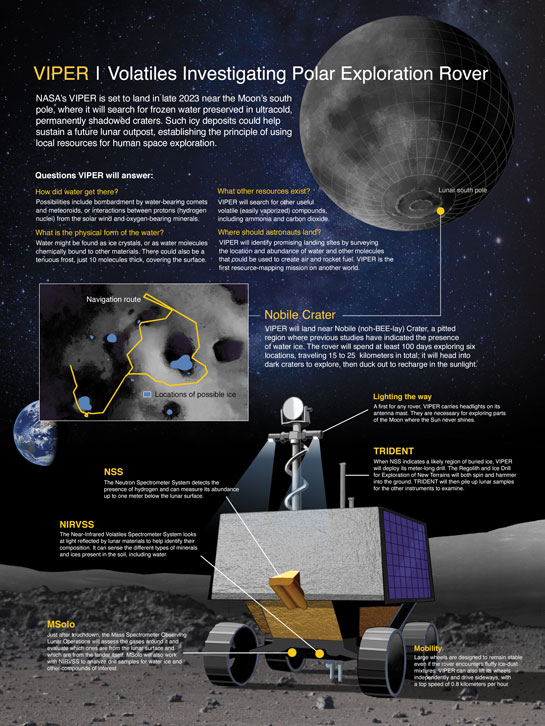
This Article From Issue
January-February 2022
Volume 110, Number 1
Page 12
NASA's VIPER is set to land in late 2023 near the Moon's south pole, where it will search for frozen water preserved in ultracold, permanently shadowed craters. Such icy deposits could help sustain a future lunar outpost, establishing the principle of using local resources for human space exploration.

Questions VIPER will answer:
How did water get there?
Possibilities include bombardment by water-bearing coments and meteoroids, or interactions between protons (hydrogen nuclei) from the solar wind and oxygen-bearing minerals.
What other resources exist?
VIPER will search for other useful volatile (easily vaporized) compounds, including ammonia and carbon dioxide.
What is the physical form of the water?
Water might be found as ice crystals, or as water molecules chemically bound to other materials. There could also be a tenuous frost, just 10 molecules thick, covering the surface.
Where should astronauts land?
VIPER will identify promising landing sites by surveying the location and abundance of water and other molecules that could be used to create air and rocket fuel. VIPER is the first resource-mapping mission on another world.
Nobile Crater
VIPER will land near Nobile (noh-BEE-lay) Crater, a pitted region where previous studies have indicated the presence of water ice. The rover will spend at least 100 days exploring six locations, traveling 15 to 25 kilometers in total; it will head into dark craters to explore, then duck out to recharge in the sunlight.
Lighting the way
A first for any rover, VIPER carries headlights on its antenna mast. They are necessary for exploring parts of the Moon where the Sun never shines.
Mobility
Large wheels are designed to remain stable even if the rover encounters fluffy ice-dust mixtures. VIPER can also lift its wheels independently and drive sideways, with a top speed of 0.8 kilometers per hour.
NSS
The Neutron Spectrometer System detects the presence of hydrogen and can measure its abundance up to one meter below the lunar surface.
TRIDENT
When NSS indicates a likely region of buried ice, VIPER will deploy its meter long drill. The Regolith and Ice Drill for Exploration of New Terrains will both spin and hammer into the ground. TRIDENT will then pile up lunar samples for the the other instruments to examine.
NIRVSS
The Near-Infrared Volatiles Spectrometer System looks at light reflected by lunar materials to help identify their composition. It can sense the different types of minerals and ices present in the soil, including water.
MSolo
Just after touchdown, the Mass Spectrometer Observing Lunar Operations will assess the gases around it and evaluate which ones are from the lunar surface and which are from the lander itself. MSolo will also work with NIRVSS to analyze drill samples for water ice and other compounds of interest.
Infographic by Gary Schroeder.

American Scientist Comments and Discussion
To discuss our articles or comment on them, please share them and tag American Scientist on social media platforms. Here are links to our profiles on Twitter, Facebook, and LinkedIn.
If we re-share your post, we will moderate comments/discussion following our comments policy.